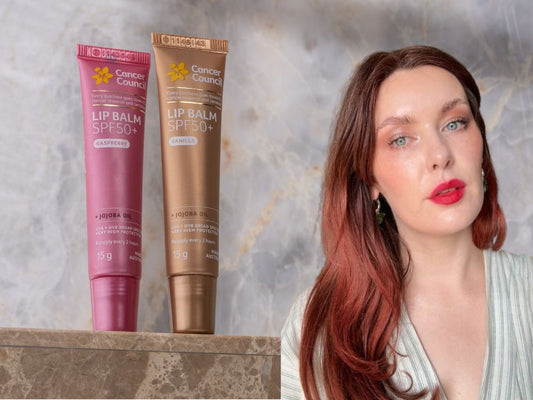As a 31-year-old millennial, I grew up with skin cancer prevention campaigns like ‘there’s nothing healthy about a tan’ and ‘tanning is skin cells in trauma’. Those ads, as other Aussies will remember, were plastered all over free-to-air TV at the time, peppered in between the most popular TV shows of the 2000s.
As I’ve reflected on the self-observed decline in sun safety amongst Gen Z, it has dawned on me that we’re struggling to reach them with skin cancer prevention messaging in the way that my generation was. We had Clare Oliver in the 2000s proving that melanoma doesn’t discriminate by age, and more recently Natalie Fornasier, both of whom were fierce advocates for skin cancer prevention until their untimely passings.
What seems to resonate most with the Gen Z audience is not the risk of skin cancer as a result of excessive UV exposure, it’s the aging implications. And yet, short-term vanity for the sake of a suntan, according to recent studies and anecdotal observations, still eclipses that.
A 2023 survey of over 1,000 Australians revealed almost half of Gen Z deliberately sit in the sun to work on their tans, with 37% knowingly using less or no sunscreen when doing so. Another 2023-24 study revealed that less than 40% of people aged 15 years and over used SPF30 or higher sunscreen on most days in late spring and summer.
So will Gen Z, like the generations before us millennials, end up living with the regret of their behaviours? As a virtual dermal therapist and sun safety advocate myself, who reviews the skin of around 100 clients a month, my answer is absolutely they will.
Research on UVA’s effects shows that prolonged exposure accelerates aging at a cellular level by inducing both genetic and epigenetic changes in dermal cells. UVA radiation’s ability to penetrate deeper into the skin compared to UVB makes it a significant contributor to cumulative DNA damage and long-term skin health impacts.
I estimate out of the clients I see monthly, who typically range in age from early 20s to early 40s, around 70% of them are showing early signs of photodamage, and around 30% are showing advanced signs of photodamage.
Due to the degradation of collagen and elastin, and damage to fibroblasts, specific concerns related to photodamage include wrinkles and fine lines, skin laxity, textural irregularities like enlarged pores, hyperpigmentation and pigmented lesions like solar lentigines, as well as telangiectasia (visible vessels) which contribute to redness and uneven skin tone.
It’s no secret that sunscreen is the number one anti-aging skincare product (which we’ll get to shortly), but other forms of protection need to be observed as well. Sunscreen is not a suit of armour – seeking shade and wearing protective clothing and accessories is critical. Think: wide-brimmed hats, sunglasses, UPF50 clothing plus your sunscreen.
And sunscreen isn’t the only anti-aging product you can use to protect and support your skin. Here are some ingredients worth considering adding to your skincare routine to best support your long-term skin health:
Vitamin C:
-
Neutralises free radicals generated by UVA exposure
-
Protects skin cells from oxidative stress and supports collagen production
Vitamin E:
-
Works synergistically with Vitamin C to reduce lipid peroxidation in the skin.
-
Protects cell membranes from ROS damage.
Niacinamide:
-
Boosts the skin’s repair mechanisms, reduces inflammation, protects against oxidative damage
Ferulic Acid:
-
Stabilises other antioxidants (like Vitamins C and E) and enhances their photoprotective effects
Polyphenols (eg Resveratrol):
-
Combat oxidative stress and inflammation, and support skin repair
Retinoids:
-
Promote cellular turnover and DNA repair
Panthenol:
-
Calms inflammation and supports skin barrier recovery
Ceramides:
-
Replenishing ceramide levels increase the skin’s resilience to external aggressors including UV rays and pollution
Or find a sunscreen that contains beneficial ingredients, like Cancer Council’s newest facial sunscreens, Hydration Boost SPF50+ and Radiance Boost SPF50+.
Hydration Boost SPF50+ contains Polyfructol Plus which is a concentrated skincare complex containing prebiotics to support skin barrier function and offer instant hydration. This broad spectrum formula also contains hydrating and plumping hyaluronic acid, and squalane which moisturises and restores suppleness to the skin.
Radiance Boost SPF50+ promotes a radiant glow with 5% niacinamide and the inclusion of mica to illuminate the complexion on application. Niacinamide can help to even skin tone, improve the appearance of fine lines and reduce the appearance of enlarged pores. It also contains skin-brightening licorice root extract and makes a very suitable primer underneath makeup.
Ultimately, the goal here is not just to reduce the prevalence of skin cancers in Australia or prevent premature aging, but to foster a culture across all generations where protecting our skin becomes second nature, and the harmful practice of overexposing our skin to the sun isn’t the norm.


